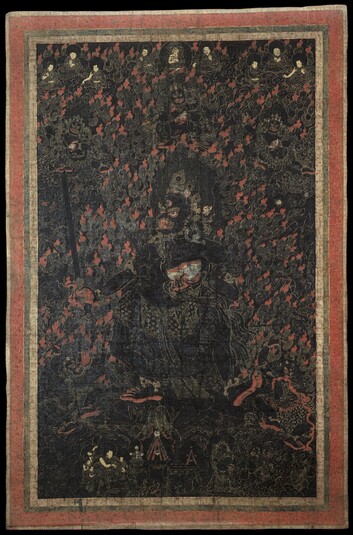
Item: Mahakala (Buddhist Protector) - Panjaranata - Retinue Figure
| Origin Location | Tibet |
|---|---|
| Date Range | 1500 - 1599 |
| Lineages | Sakya, Ngor (Sakya) and Buddhist |
| Material | Black Background on Cotton |
| Collection | Publication: Art of the Himalayas |
Classification: Deity
Appearance: Wrathful
Gender: Both
Putra: attendant to Panjanata Mahakala.
The black ground painting vividly portrays Putra Nagpo, the central figure is identified by his distinct implements: a straight sword in his right hand and a skull-cup filled with blood in the left. His attire is striking, adorned with a crown of dried skulls, silk trousers, and a black silk scarf draping across his upper body. Additionally, he is embellished with gold jewelry, an artistic addition not originally described in the textual iconography. Putra's wrathful expression is intensified by a protruding tongue, bared canine teeth, bulging eyes, and hair bristling upwards, all set against a backdrop of flames representing pristine awareness. His black body, smeared with human grease and blood, further emphasizes his fearsome demeanor.
Putra holds a prominent position as one of the five inner attendant deities of Panjaranatha Mahakala, the principle wisdom protector of the Sakya tradition of Tibetan Buddhism. This group of five forms a familial unit, comprising Kala Rakshasa (the father), Kala Rakshasi (the mother), and their three children. Typically, they are represented beneath the painted image of Panjaranata Mahakala as attendant or servant figures. In this specific work, Panjaranatha Mahakala is directly positioned above Putra although in a smaller diminutive size.
Flanking the figure of Putra are his two siblings, Batha and Ekajati Rakshasi (Singmo), positioned to the left and right, respectively. Batha, black-skinned, is depicted wearing a tiger skin skirt, brandishing a wooden stick upraised in the right hand and a human heart in the left. Singmo, also black in color, holds a golden razor in her right hand and grotesquely grasps intestines held to her mouth with the left. The three, enraged and wrathful, form the central subject of the painting.
The four sides of the composition are framed with three inner borders. The borders feature depictions of orange fire, blue vajras, and white skulls, notable elements shared with other works, such as Himalayan Art Resource number 83480. However, item 83480 highlights only the skull border. Additional unpublished examples display all three of the unique borders. This appears to be a signature characteristic of a wrathful set created most likely by a Sakya town painting atelier. Although dated to the 16th century, black-ground compositions existed prior to the 14th century. The total number of paintings belonging to this particular set remains uncertain.
Shinzo Shiratori 7-2024
Mahakala: Panjarnata, Lord of the Pavilion (Main Page)
Painting Tradition: Khyenri, Black Ground
Painting Type: Black Ground Main Page
Buddhist Protector: Putra Mising Nga (Five Activity Protectors)
Mahakala (Rare & Unusual Forms)
Subject: Panjarnata Eight Deity (Sakya Atelier)

